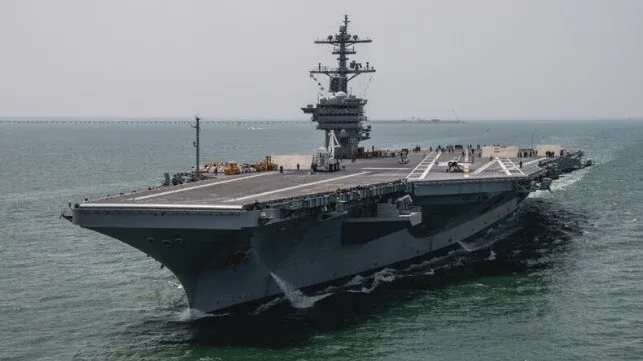USS George Washington, a Nimitz-class aircraft carrier powered by two nuclear reactors, was officially returned to the United States Navy on May 25, after a six-year-long overhaul that revealed weaknesses in the Navy's systems. The carrier's redelivery is almost two years behind schedule, and comes after it was linked to the suicides of nine sailors in 2017.
The carrier, which had been deployed on a first-in-first-out basis from its home base in Japan from 2008 to 2015, embarked on its ROCO (Mid-Life Refueling and Complex overhaul) on Aug. 4, 2017, under a $2.8-billion contract with Newport News Shipbuilding of Virginia. According to the Navy, the ROCO includes not only refueling of the carrier's two nuclear reactors, but also upgrades to its propulsion equipment, infrastructure and combat systems.
This has been a difficult RCOH process in many ways, and the team that executed the RCOH involved the shipbuilder, the GW crew, and a variety of suppliers and Navy commands to deliver this aircraft carrier again during the pandemic, by re-engineering our approach to work with our suppliers and our shipyard, and accelerating problem-solving on the deck plates.
“I’ve been overseeing recent years of the extended 69-month process for the delivery of the George Washington,” Navy Rear Adm.James P. Downey said in a statement. “The process faced challenges due to COVID-19, supplier interruptions and competing demands on resources.”
The shipyard said the process included upgrades to nearly every area and system on the vessel, including tanks, the hull, shoring, propellers, and rudders, as well as electrical, combat, and aviation support systems. The process also included the defueling, refueling, and upgrading of the ship's two nuclear reactors. The ship's propulsion plant was also repaired, maintained, and upgraded.
HHI cites a number of reasons for the extended schedule. Beyond the pandemic, HHI cites budget uncertainty, workforce shortages, and the ship’s condition at the time of arrival at the yard, a survey revealed more extensive problems. During the overhaul, the Navy chose to use parts from Washington for other vessels within the Nimitz fleet, adding to the inventory of materials the yard needed to build for the carrier.
 |
| Return from the acceptance trials marked the end to a troubled overhaul that highlighted shortcomings in the process (HHI) |
The Washington's return from the acceptance trials marks the conclusion of a troubled overhaul that revealed weaknesses in the process.
"The George Washington has undergone a complete overhaul and is now ready to support all missions and continue to serve our nation for the next 25 years," Todd West, Vice President, In-Service Aircraft Carrier Programs, NNS, said in a statement. "The carrier's systems and operations have been thoroughly tested during her time at sea."
On May 22, the carrier left Newport News, Virginia, for three days of acceptance trials. During the time at sea, the carrier underwent high-speed operations, as well as a series of tests to demonstrate system performance and to demonstrate all the carrier's capabilities at sea.
The acceptance trials concluded on May 25, when the carrier was officially returned to port and delivered to the United States Navy.
Washington’s commanding officer Capt Brent Gaut said, “We have redelivered our warship and put her back on the high seas to take her place as the flagship of the greatest Navy in the world. The tenacity and courage of our warfighters is a testament to how far we have come. To our amazing Sailors, Contractors, and Shipyard workers: I am so proud of you. I hope you are feeling an extreme amount of pride too, especially knowing that we have achieved something once in a lifetime.”
Because the Washington spent so much time in the yard, sailors were able to join her and spend the entire tour on board without ever leaving the ship. After three sailors killed themselves in the span of a week, the Navy conducted a number of investigations and admitted conditions aboard the ship were extremely difficult during the lengthy refit.
The reports included a lengthy list of quality of life issues and recommendations for conditions aboard vessels during extended shipyard stay, as well as requests to make more off-ship housing available.
The George Washington will be replaced by the USS Ronald Reagan in 2024, which relieved the Washington in 2015, according to the Navy. The Ronald is scheduled to move to the USS Bremerton in Washington, D.C., where the ship is scheduled to receive repairs and upgrades this year. The Ronald has been deployed to the Western Pacific for nearly a decade.


